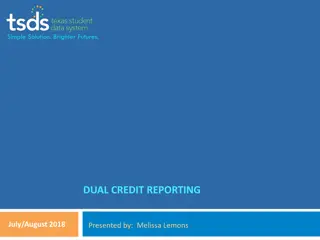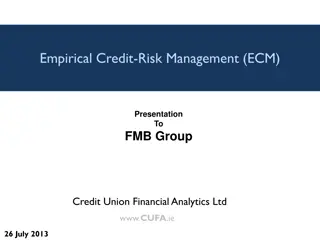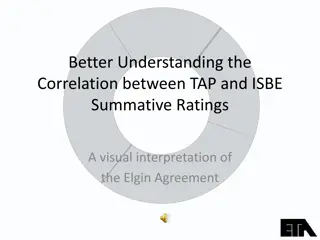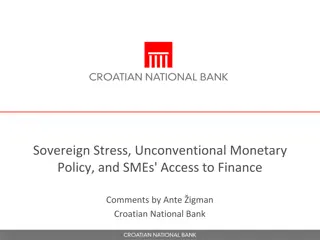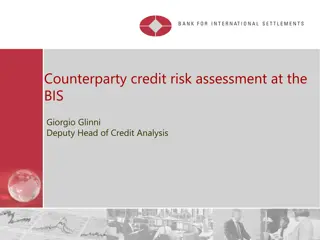Understanding the Importance of Sovereign Credit Ratings
Sovereign credit ratings play a crucial role in assessing the creditworthiness of countries, influencing borrowing costs, investor confidence, access to international markets, economic policy evaluation, and risk management. Ratings agencies evaluate various factors to determine a country's credit rating, impacting its ability to borrow funds, attract investments, and manage financial risks effectively.
Download Presentation

Please find below an Image/Link to download the presentation.
The content on the website is provided AS IS for your information and personal use only. It may not be sold, licensed, or shared on other websites without obtaining consent from the author. Download presentation by click this link. If you encounter any issues during the download, it is possible that the publisher has removed the file from their server.
E N D
Presentation Transcript
Session-4 Credit Rating-Sovereign Rating
Approach in Sovereign Rating i. Quantitative Approach ii. Qualitative Approach What do you understand by Sovereign Rating i. Definition ii. Importance of Sovereign credit ratings Sovereign Rating for few countries Different scores to measure Sovereign Credit Rating Credit Rating Description Case Study Determinants used in evaluation of sovereign rating
What do you understand by Sovereign Rating A sovereign rating, also known as a credit rating, is an assessment of the creditworthiness of a country or sovereign entity. It is provided by credit rating agencies, such as Standard & Poor's (S&P), Moody's, and Fitch Ratings. These agencies evaluate the financial and economic stability of a country and assign a rating based on their analysis.
Importance of Sovereign Credit Rating Sovereign credit ratings are important for several reasons: 1.Borrowing Costs: Sovereign credit ratings affect the borrowing costs of a country. Higher credit ratings indicate lower risk, and thus, countries with better ratings can borrow money at lower interest rates. This allows governments to finance their operations and invest in infrastructure, healthcare, education, and other areas at a lower cost. 2.Investor Confidence: Credit ratings provide investors with an assessment of a country's creditworthiness. A higher rating suggests lower risk and greater confidence in a country's ability to repay its debts. This can attract foreign investors and increase the inflow of capital, stimulating economic growth and development.
Contd.--- Importance of Sovereign Credit Rating 3.Access to International Markets: Countries with higher credit ratings have better access to international financial markets. They can issue bonds and other debt instruments at favorable terms, attracting a broader range of investors. This enables governments to diversify their funding sources and raise capital for various projects and initiatives. 4.Economic Policy Evaluation: Credit ratings provide an independent assessment of a country's economic and financial stability. They can be useful for evaluating a government's economic policies, fiscal discipline, and overall governance. Ratings agencies analyze factors such as economic growth, debt levels, fiscal deficits, political stability, and institutional strength to determine a country's credit rating. 5.Risk Management: Credit ratings assist investors and financial institutions in managing risk. Ratings agencies assess the likelihood of a country defaulting on its debt obligations, which helps investors make informed decisions about allocating their capital. Institutions can use these ratings as a benchmark for risk management and to comply with regulatory requirements.
Determinants used in evaluation of sovereign rating When evaluating the sovereign rating of a country, credit rating agencies typically consider various determinants to assess the creditworthiness and risk associated with the country's debt obligations. A. Economic Indicators B. Fiscal Performance C. External Position D. Political and Institutional Factors E. Access to Capital Markets F. Socioeconomic Factors G. Geopolitical Risks
Approach of Sovereign Rating Qualitative Approach Quantitative Approach
Sovereign Rating basis When analyzing sovereign ratings, both quantitative & qualitative approaches are commonly used to assess the creditworthiness and risk associated with a particular country. These approaches provide complementary perspectives and help in forming a comprehensive rating opinion. Quantitative Approach: 1.Economic Indicators: Quantitative data such as GDP growth rate, inflation rate, unemployment rate, fiscal deficit, current account balance, and debt-to-GDP ratio are analyzed to gauge the economic health and stability of a country. These indicators provide numerical measurements of economic performance and fiscal discipline. 2.Financial Metrics: Financial data related to government revenues, expenditures, budgetary policies, and debt dynamics are assessed. Factors like revenue diversification, government debt affordability, interest payment coverage ratio, and debt maturity profile are considered to evaluate the financial strength and sustainability of a country. 3.Historical Performance: Historical trends and patterns are examined to understand a country's track record in meeting its financial obligations. Analysis of past defaults, repayment delays, or restructuring events helps assess the creditworthiness and repayment capacity of the sovereign.
4. Fiscal Indicators: Budget deficit: Evaluating the extent to which a government spends more than it collects in revenues. Revenue and expenditure composition: Analyzing the sources of government revenue and the allocation of public expenditures. Tax revenues as a percentage of GDP: Assessing the efficiency and effectiveness of the tax system. 5. External Sector Indicators: Current account balance: Evaluating the country's trade balance and its ability to generate foreign currency. Foreign exchange reserves: Assessing the adequacy of reserves to cover external obligations and potential shocks. Exchange rate stability: Analyzing the volatility and stability of the country's currency. 6. Financial Sector Stability Bank non-performing loan (NPL) ratio: Assessing the health of the banking sector and its ability to absorb shocks. Capital adequacy ratio: Evaluating the financial soundness and resilience of banks. Regulatory framework: Analyzing the effectiveness of financial sector regulations and supervision 7. Sovereign Credit Spread: Analyzing the yield spreads between a country's sovereign bonds and benchmark bonds, such as U.S. Treasury bonds. Spreads can indicate market perceptions of credit risk and investor confidence in the country's ability to repay its debt.
Qualitative Approach: 1.Institutional Factors: The effectiveness of a country's political and legal institutions, including governance, transparency, and rule of law, is evaluated. Stable political systems, strong institutions, and clear legal frameworks are generally considered positive indicators for sovereign creditworthiness. 2.Policy Environment: Assessment of a country's policy framework, including monetary policy, fiscal policy, and regulatory environment, helps evaluate the government's ability to maintain stability, promote economic growth, and manage financial risks effectively. 3.External Factors: Factors such as geopolitical risks, external shocks, commodity price volatility, and exposure to international trade are considered. These factors assess the vulnerability of a country to external pressures and its ability to withstand and recover from adverse events. 4.Social and Demographic Factors: Socioeconomic indicators like education levels, human development, income distribution, social stability, and demographic trends are taken into account. These factors provide insights into a country's social resilience, human capital development, and potential economic growth prospects. Combining both approaches allows credit rating agencies and investors to gain a more comprehensive understanding of a sovereign's creditworthiness. While the quantitative approach relies on numerical data and financial metrics, the qualitative approach captures broader factors that influence a country's ability to meet its obligations and manage risks effectively.
5. Monetary Policy & Central Bank Independence Assessing the independence and effectiveness of the central bank in formulating and implementing monetary policy. Analyzing factors such as inflation control, exchange rate stability, and credibility of monetary policy decisions. 6. Geopolitical Risk Examining geopolitical factors such as regional conflicts, territorial disputes, and potential threats to stability. Analyzing the impact of geopolitical risks on a country's economic prospects and ability to attract investment.
Different Scores to measure Sovereign Credit Rating a. Political Score b. Macro Economic Score c. External finance Score d. Fiscal Score e. Monetary & Liquidity Score
THANK YOU THANK YOU









